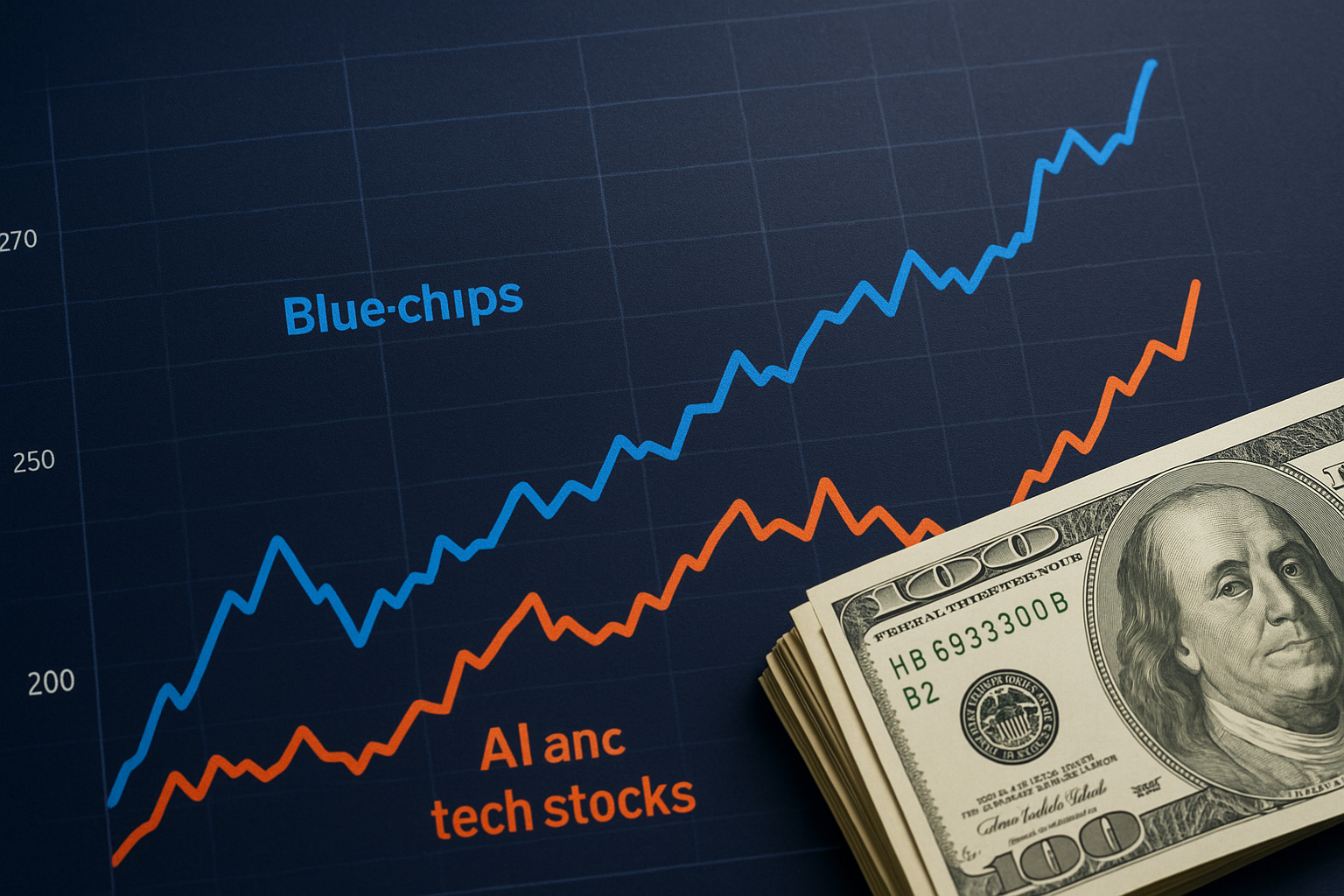The market is showing signs of a long-awaited shift. After months of dominance by AI and high-growth tech stocks, investors appear to be rotating into blue-chip and value names, signaling a possible recalibration in risk appetite. The Dow Jones Industrial Average climbed roughly 1.2% to a record high this week, while the Nasdaq and S&P 500 tech components lagged. With inflation data softening but earnings visibility tightening across the AI sector, fund managers are rebalancing toward dividend payers and cyclical stalwarts.
Blue-Chips Regain the Spotlight
According to Barron’s and Reuters, the Dow’s latest rally marks a significant rotation into traditional industries—energy, financials, and consumer staples—many of which had underperformed during the 2024–2025 AI-led market run. This rotation is driven partly by valuations: mega-cap tech names such as Nvidia, Microsoft, and Alphabet, which soared on AI optimism earlier this year, are now facing scrutiny over stretched multiples and slowing earnings momentum.
The trend suggests that institutional investors are repositioning for stability as macroeconomic uncertainty persists. The CBOE Volatility Index (VIX) ticked higher in recent sessions, reflecting a cautious mood even as headline indices remain near record levels.
Why This Matters for Investors
The ongoing shift hints that the market’s leadership could be broadening, a dynamic often seen during the later stages of economic expansions. With central banks signaling a “higher-for-longer” stance on interest rates, yield-sensitive investors are seeking refuge in dividend-rich blue-chips and defensive sectors.
According to Morgan Stanley Research, dividend yields among Dow components now average roughly 2.4%, compared to just 0.8% across leading AI stocks in the Nasdaq 100. This yield advantage, combined with steadier cash flows, has rekindled interest in industrials, banks, and healthcare firms.
Meanwhile, the AI and semiconductor sectors—the main engines of 2025’s early market gains—are encountering valuation fatigue. Investors are scrutinizing margins, capital expenditure trends, and return-on-investment metrics for AI infrastructure projects, as profitability expectations moderate from exuberant early-year levels.
Analyst Views: “Healthy Rotation” or “Early Warning”?
Market strategists remain divided on whether this move represents a temporary correction or a long-term structural pivot.
- Barclays Equity Strategy notes that “value stocks have historically outperformed during rate plateaus and in late-cycle conditions,” suggesting the shift could persist.
- Conversely, Goldman Sachs analysts argue that the market could see “mini-rotations” rather than a full reversal, especially if AI earnings rebound in the next two quarters.
Nonetheless, fund flow data supports the current narrative: Lipper reported over $4.2 billion in inflows to value ETFs last week, while growth-focused funds saw net redemptions.
Future Trends to Watch
Several macro factors could determine whether this rotation accelerates:
- Earnings Guidance for Q4 2025: If tech companies lower forecasts or trim capex, investor confidence could further erode.
- Interest Rate Outlook: A prolonged high-rate environment would benefit financials and hurt leveraged growth sectors.
- Fiscal Policy Developments: Infrastructure spending and energy transition policies could strengthen traditional industrials.
Additionally, geopolitical risks and shifting supply chains are making diversified balance sheets more attractive—another tailwind for blue-chip stability.
Key Investment Insight
Investors should reassess exposure to high-valuation growth names, particularly those with unproven profit models. A selective rotation into value, dividend, and defensive sectors could offer better risk-adjusted returns over the next 6–12 months. Sectors like healthcare, industrials, and consumer staples may serve as effective hedges if the market broadens or volatility spikes.
Consider maintaining a barbell strategy—balancing quality growth stocks with income-oriented blue-chips—to capture upside while mitigating downside risk.
Stay Ahead with MoneyNews.Today
As global capital flows adjust and equity leadership rotates, keeping track of market sentiment shifts is crucial. Stay tuned with MoneyNews.Today for daily investor insights, sector analyses, and actionable updates across the AI, technology, and broader stock markets.





